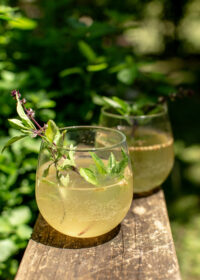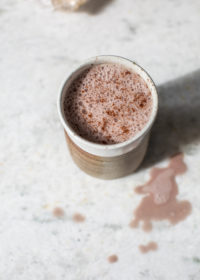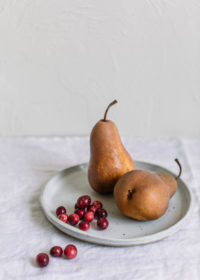Recipes: Spring Kombucha + Homebrewing 101
 I’ve been creating seasonal content for our gorgeous local print magazine here, Edible OKC. I’ve long loved Edible’s global mission to support regional food culture and highlight local foodies. It’s been such an honor to be a part of the magazine and to have the creative space to share recipes/photography in my little “Conscious Cooking” corner on the mag! Last month, I shared chocolate rose truffles and herbal love potion tea for the February issue to go along with their local Coffee Roasters issue. This month’s theme is Fermentation, so naturally, as the weather warms up, sharing a few of my favorite springtime kombucha recipes seemed like perfect timing! And even better – we’ll also be hosting a hands-on Kombucha Brewing Workshop this month at the Edible Headquarters, so if you’re in the area come join us March 19th from 2-4pm to learn how to homebrew and take home a completed kombucha kit to start brewing! More details on the event here.
I’ve been creating seasonal content for our gorgeous local print magazine here, Edible OKC. I’ve long loved Edible’s global mission to support regional food culture and highlight local foodies. It’s been such an honor to be a part of the magazine and to have the creative space to share recipes/photography in my little “Conscious Cooking” corner on the mag! Last month, I shared chocolate rose truffles and herbal love potion tea for the February issue to go along with their local Coffee Roasters issue. This month’s theme is Fermentation, so naturally, as the weather warms up, sharing a few of my favorite springtime kombucha recipes seemed like perfect timing! And even better – we’ll also be hosting a hands-on Kombucha Brewing Workshop this month at the Edible Headquarters, so if you’re in the area come join us March 19th from 2-4pm to learn how to homebrew and take home a completed kombucha kit to start brewing! More details on the event here.
 Now, for those new to this fizzy drink, kombucha is a lightly fermented tea rich with gut-friendly probiotics, active enzymes, amino acids and polyphenols. It’s naturally carbonated, making it a fabulous healthy alternative to sugary processed sodas. For the curious home-brewer, it’s an easy process with endless possibilities to alchemize your favorite flavors.
Now, for those new to this fizzy drink, kombucha is a lightly fermented tea rich with gut-friendly probiotics, active enzymes, amino acids and polyphenols. It’s naturally carbonated, making it a fabulous healthy alternative to sugary processed sodas. For the curious home-brewer, it’s an easy process with endless possibilities to alchemize your favorite flavors.
Kombucha starts out as a sugary tea, which is then fermented for 2-3 weeks using a live culture known in the ‘buch world as a SCOBY (Symbiotic Culture of Bacteria and Yeast). The kombucha gets its unique flavor and probiotic power because the scoby actually ‘eats’ the sugar and components of the tea leaving nutritious kombucha to enjoy. In the home ‘buch brewing culture, you can ask a friend for a piece of their SCOBY to get started, or grow your own with starter kit. Here’s what else you’ll need…
 SUPPLIES
SUPPLIES
2 gallon glass jar
clean tea towel & rubber band
pitcher
funnel
glass bottles/jars with lids
INGREDIENTS
2 gallons distilled water
2 cups organic cane sugar
20 tea bags (black, green, yerba mate or a mix)
1 SCOBY (mother culture)
Place the sugar and tea bags in the clean glass jar. Boil the water and fill your jar halfway. Allow to steep for 10-15 minutes until a dark brew is made. Remove tea bags using a clean wooden spoon and fill the jar with cool water until 90% full. When the tea has cooled enough to room temperature, add in your SCOBY. Avoid placing the live culture in hot liquid as this will kill the beneficial working bacteria. Cover top with a clean tea towel and secure with a rubber band. Label the date on the jar, and store in a warm, dry place out of direct sunlight and away from other fermenting products. Ferment for 14 days, checking to make sure mold does not occur on the top of the culture. If you find mold (it’ll be pretty obvious & look like this) , throw the batch out and begin again. Smelling your kombucha is a good way to know if things are on track or not. If it has an unusually foul or funky odor, it’s probably best to take the safe route and start a fresh batch. After two weeks, taste the kombucha. It should be tart and zingy, not overly sweet or sour. If the brew seems too thick and sweet, continue to ferment for another 3-5+ days to allow more time for the culture to consume the sugar and you like the taste of where it’s at. Depending on how hot or cold it is in your home will affect the first ferment time. Some people keep their brews in a warmer place or even under heat lamps to speed up ferment time in colder months. Just make sure it’s too hot or in direct sunlight, as this will kill the SCOBY.
When ready your brew is ready, remove the SCOBY from the jar with clean hands and place in a bowl with enough kombucha poured over top to cover the culture. This will be your starter for the next batch! Pour the remaining jar of kombucha into a pitcher. Then, using funnels if needed, divide kombucha into individual glass bottles or jars and seal with airtight lids. It’s important to fill the bottles all the way to top, leaving very little room for air. At this point, you can add a variety of fruit, herbs and spices – whole or juiced – to each bottle to flavor in the second fermentation stage or you can bottle alone and flavor with fresh juice after the second ferment is complete. Once you decide on your flavoring route, place these bottles back in a warm dry spot and allow to ferment with the lids on for 2-3 days. This will carbonate the kombucha giving it that lovely effervescent quality. Be sure to “burp” the bottles each day in this second fermentation stage. Burping means to unpop or unscrew the lid for a moment to relieve the excess pressure from the natural carbonation process. To stop this process, transfer the jars to the fridge and keep cold until ready to drink. If you keep the second fermentation stage going for too long, it may turn too sour to drink. Wondering why it’s not extra fizzy? Your favorite store-bought kombucha brands CO2 carbonate their brews so their extra bubbly when you get them. You won’t achieve this level of fizz on it’s own, but it will get lightly effervescent in the second ferment stage.
 ALCHEMIZE
ALCHEMIZE
Below are three varieties of my favorite springtime kombucha recipes using both methods of flavoring. Try your hand at second ferment flavoring and fresh juice flavoring!
Strawberry Basil Kombucha
10 strawberries, stems removed & cut in half
20 leaves basil
Add 4-5 sliced strawberries and 2 leaves basil to each bottle of kombucha. Seal with lid and allow to sit at room temp for 2-3 days for the second ferment. Store in fridge until ready to drink, strain out
 Carrot Orange Turmeric Kombucha
Carrot Orange Turmeric Kombucha
6 carrots
2 inches fresh ginger root
1 knob fresh turmeric root
2 oranges, peeled
Process all ingredients through a juicer. Filter juice through a strainer into a pitcher. Pour 2oz of juice into each jar of kombucha to flavor. Enjoy right away or seal with a lid and store in fridge until ready to drink. You can choose to second ferment with the juice for a more effervescent quality or second ferment without the juice. With fresh juice, I like to bottle up plain kombucha after the first ferment and allow it sit in the bottle unflavored for a more effervescent quality for 2-3 days. Then, I add my fresh juice and enjoy right away or store in the fridge until ready to drink.
 Grapefruit Mint Kombucha
Grapefruit Mint Kombucha
2 grapefruits, peeled
1 bunch mint
Process all ingredients through a juicer. Filter juice through a strainer into a pitcher. Pour 2oz of juice into each bottle of kombucha to flavor. Enjoy right away or seal with a lid and store in fridge until ready to drink. You can choose to second ferment with the juice for a more effervescent quality or second ferment without the juice. With fresh juice, I like to bottle up plain kombucha after the first ferment and allow it sit in the bottle unflavored for a more effervescent quality for 2-3 days. Then, I add my fresh juice and enjoy right away or store in the fridge until ready to drink.
 [wpmenucart]
[wpmenucart] Recipe: Cooling Coriander, Basil & Lime Drink
Recipe: Cooling Coriander, Basil & Lime Drink  Recipes: Tahini Hot Chocolate
Recipes: Tahini Hot Chocolate  Recipes: Mulled Rose & Cranberry Pear Cider
Recipes: Mulled Rose & Cranberry Pear Cider 
These all look delicious, Claire! I’ve got to get on the kombucha-making train!
Yes! I’d taken a few year hiatus from home brewing and have loved getting back on the band wagon. It’s really so simple once you start making it and get past the weird fear of a big mushroom growing in your kitchen